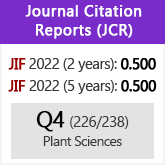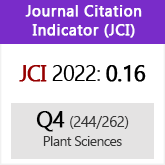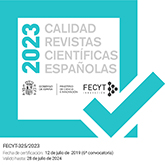Carbon storage of Mediterranean grasslands
DOI:
https://doi.org/10.3989/ajbm.2406Keywords:
Ampelodesmos mauritanicus, carbon storage, Hyparrhenia hirta, Mediterranean grasslands, Pennisetum setaceumAbstract
Secondary grasslands are one of the most common vegetation types worldwide. In Europe, and in the Mediterranean basin, human activities have transformed many woodlands into secondary grasslands. Despite their recognized role in the global carbon cycle, very few data are available for estimating the biomass of Mediterranean grasslands. We developed linear regression models in order to predict the biomass of two native Mediterranean grasses (Ampelodesmos mauritanicus and Hyparrhenia hirta) and an invasive alien grass (Pennisetum setaceum). Ampelodesmos mauritanicus is very common throughout the Mediterranean basin, mostly on north-facing slopes, H. hirta characterizes thermo-xeric grasslands, while P. setaceum is an alien species that is rapidly spreading along coastal areas. The measured morphometric attributes of individual plants as potential predictors were considered. The validation results corroborate the ability of the established models to predict above ground and total biomass of A. mauritanicus and P. setaceum. We also evaluated the total biomass per hectare for each species. The highest biomass per hectare was found for A. mauritanicus, whereas biomass was higher for H. hirta than for P. setaceum. The replacement of H. hirta by P. setaceum may reduce the total carbon storage in the ecosystem; however, P. setaceum allocates more resources to the roots, thus increasing the more stable and durable pool of carbon in grasslands.
Downloads
References
AA VV. 1996. Linee-guida del Piano Territoriale Paesistico Regionale, Regione Siciliana. Assessorato Beni Culturali e Ambientali e Pubblica Istruzione, Palermo.
Abberton, M., Conant, R. & Batello, C. 2009. Grassland carbon sequestration: management, policy and economics. Proceedings of the Workshop on the role of grassland carbon sequestration in the mitigation of climate change 11. FAO, Integrated Crop Management, Rome. PMid:18639548
Barbaro, L., Dutoit, T. & Cozic, P. 2001. A six-year experimental restoration of biodiversity by shrub-clearing and grazing in calcareous grasslands of the French Prealps. Biodiversity and Conservation 10: 119-135. http://dx.doi.org/10.1023/A:1016629507196
Bonanomi, G., Caporaso, S. & Allegrezza, M. 2006. Short-term effects of nitrogen enrichment, litter removal and cutting on a Mediterranean grassland. Acta Oecologica 30: 419-425. http://dx.doi.org/10.1016/j.actao.2006.06.007
Brullo, C., Brullo, S., Giusso del Galdo, G. & al. 2010. The Lygeo-Stipetea class in Sicily. Annali di Botanica 0: 57-84. Available at: http://ojs.uniroma1. it/index.php/Annalidibotanica/article/view/9119.
Chejara, V.K., Kristiansen, P., Whalley, R.D.B. & al. 2008. Factors affecting germination of Coolatai Grass (Hyparrhenia hirta). Weed Science 56: 543-548. http://dx.doi.org/10.1614/WS-07-163.1
Ciais, P., Soussana, J.F., Vuichard, N. & al. 2010. The greenhouse gas balance of European grasslands. Biogeosciences Discussions 7: 5997-6050. http://dx.doi.org/10.5194/bgd-7-5997-2010
Cleemput, S., Muys, B., Kleinn, C. & Janssens, M.J.J. 2004. Biomass estimation techniques for enclosures in a semi-arid area: a case study in Northern Ethiopia. Deutscher Tropentag, "Rural Poverty Reduction through Research for Development", October 5-7, 2004 Berlin, 6 pp. Available at: http://www.tropentag.de/2004/abstracts/full/3.pdf.
CLC (Corine Land Cover). 1990. Scala 1:100.000. http://www.sinanet. isprambiente.it/it/sia-ispra/download-mais/corine-land-cover/ corine-land-cover-1990/view.
CLC (Corine Land Cover). 2000. Agenzia per la Protezione dell'ambiente e per i servizi tecnici (APAT) scala 1:100.000. http://www.sinanet. isprambiente.it/it/sia-ispra/download-mais/corine-land-cover/ corine-land-cover-2000/view.
CLC (Corine Land Cover). 2006. http://www.sinanet.isprambiente.it/it/ sia-ispra/download-mais/corine-land-cover/corine-land-cover-2006/view.
Cordell, S. & Sandquist, D.R. 2008. The impact of an invasive African bunchgrass (Pennisetum setaceum) on water availability and productivity of canopy trees within a tropical dry forest in Hawaii. Functional Ecology 22: 1008-1017. http://dx.doi.org/10.1111/j.1365-2435.2008.01471.x
Corona, P., Barbati, A., Tomao, A. & al. 2012. Land use inventory as framework for environmental accounting: an application in Italy. iForest 5: 204-209.
Costa, G. & La Mantia, T. 2005. Il ruolo della macchia mediterranea nello stoccaggio del carbonio atmosferico. Forest@ 2: 378-387. http://dx.doi.org/10.3832/efor0319-0020378
De Deyn, G.B., Shiel, R.S., Ostle, N.J. & al. 2011. Additional carbon sequestration benefits of grassland diversity restoration. Journal of Applied Ecology 48: 600-608. http://dx.doi.org/10.1111/j.1365-2664.2010.01925.x
Dost.lek, J. & Frant.k, T. 2008. Dry grassland plant diversity conservation using low-intensity sheep and goat grazing management: case study in Prague (Czech Republic). Biodiversity and Conservation 17: 1439-1454.
Drago, A., Lo Bianco, B. & Monterosso, I. 2002. Atlante climatologico della Sicilia. Assessorato Agricoltura e Foreste. Servizio Informativo Agrometereologico Siciliano. Regione Siciliana. Available at: www.sias. regione.sicilia.it.
Draper, N.R. & Smith, H. 1981. Applied regression analysis. 2nd ed. John Wiley, New York.
EC. 1992. Council Directive 92/43/EEC of 21 May 1992 on the conservation of natural habitats and of wild fauna and flora. Available at: http:// eur-lex.europa.eu/LexUriServ/LexUriServ.do?uri=CELEX:31992L0043:EN:html.
FAO (Food and Agricultural Organization of the United Nations) 2006. FAO Statistical Yearbook. FAOSTAT.
Fierotti, G. 1988. Carta dei suoli della Sicilia (scala 1:250.000). Regione Siciliana, Ass. TT. AA. Univ. Palermo, Fac. Agraria, Ist. Agron. Generale, Cattedra di Pedologia.
FRA. 2010. Global Forest Resources Assessment. Available at: http://www. fao.org/forestry/fra/fra2010/en/ (accessed 20 July 2014).
Gilmanov, T.G., Soussana, J.F., Aires, L. & al. 2007. Partitioning European grassland net ecosystem CO2 exchange into gross primary productivity and ecosystem respiration using light response function analysis. Agriculture Ecosystems and Environment 121: 93-120. http://dx.doi.org/10.1016/j.agee.2006.12.008
Golodets, C., Kigel, J. & Sternberg, M. 2010. Recovery of plant species composition and ecosystem function after cessation of grazing in a Mediterranean grassland. Plant and Soil 329: 365-378. http://dx.doi.org/10.1007/s11104-009-0164-1
Grigulis, K., Lavorel, S., Davies, I.D. & al. 2005. Landscape-scale positive feedbacks between fire and expansion of the large tussock grass, Ampelodesmos mauritanica in Catalan shrublands. Global Change Biology 11: 1042-1053. http://dx.doi.org/10.1111/j.1365-2486.2005.00980.x
Grill, A., Knoflach, B., Cleary, D.F.R. & Kati, V. 2005. Butterfly, spider, and plant communities in different land-use types in Sardinia, Italy. Biodiversity and Conservation 14: 1281-1300. http://dx.doi.org/10.1007/s10531-004-1661-4
Harrison, S., Inouye, B.D. & Safford, H.D. 2003. Ecological Heterogeneity in the Effects of Grazing and Fire on Grassland Diversity. Conservation Biology 17: 837-845. http://dx.doi.org/10.1046/j.1523-1739.2003.01633.x
Hector, A., Schmid, B., Beierkuhnlein, C. & al. 1999. Plant diversity and productivity experiments in European grasslands. Science 286: 1123-1127. http://dx.doi.org/10.1126/science.286.5442.1123 PMid:10550043
Hofmann, A., Cibella, R., Bertani, R. & al. 2011. Strumenti conoscitivi per la gestione delle risorse forestali della Sicilia. Sistema Informativo Forestale. Assessorato Territorio e Ambiente Regione Siciliana.
Hungate, B.A., Holland, E.A., Jackson, R.B. & al. 1997. The fate of carbon in grasslands under carbon dioxide enrichment. Nature 388: 576-579. http://dx.doi.org/10.1038/41550
Janssens, I.A., Freibauer, A., Ciais, P. & al. 2003. Europe's terrestrial biosphere absorbs 7 to 12% of European anthropogenic CO2 emissions. Science 300: 1538-1542. http://dx.doi.org/10.1126/science.1083592 PMid:12764201
Janssens, I.A., Freibauer, A., Schlamadinger, B. & al. 2005. The carbon budget of terrestrial ecosystems at country-scale, a European case study. Biogeosciences 2: 15-26. http://dx.doi.org/10.5194/bg-2-15-2005
Jones, M.B. 2010. Potential for carbon sequestration in temperate grassland soils. In: Abberton, M., Conant, R. & Batello, C. (eds.), Grassland carbon sequestration: management, policy and economics. Proceedings of the Workshop on the role of grassland carbon sequestration in the mitigation of climate change. Integrated Crop Management 11. FAO, Roma, pp. 18.
Litav, M. 1972. Factors determining the distribution pattern of Hyparrhenia hirta (L.) Stapf. on different expositions and slopes in the Judean hills. Israel Journal of Botany 21: 76-89.
Litton, C.M., Sandquist, D.R. & Cordell, S. 2006. Effects of non-native grass invasion on aboveground carbon pools and tree population structure in a tropical dry forest of Hawaii. Forest Ecology and Management 231: 105-113. http://dx.doi.org/10.1016/j.foreco.2006.05.008
Mannetje ('t), L. 2007. The role of grasslands and forests as carbon stores. Tropical Grasslands 41: 50-54.
McArdle, S.L., Nadolny, C. & Sindel, B.M. 2004. Invasion of native vegetation by Coolatai grass Hyparrhenia hirta: impacts on native vegetation and management implications. Pacific Conservation Biology 10: 49-56. http://dx.doi.org/10.1071/PC040049
McWilliam, J.R., Shanker, K. & Knox, R.B. 1970. Effects of temperature and photoperiod on growth and reproductive development in Hyparrhenia hirta. Australian Journal of Agricultural Research 21: 557-569. http://dx.doi.org/10.1071/AR9700557
Mingo, A. & Mazzoleni, S. 1997. Ecophysiology of five Mediterranean perennial grasses: I) Effects of shade, water stress and defoliation on growth and allocation. Plant Biosystems 131: 207-215. http://dx.doi.org/10.1080/11263504.1997.10654183
Minissale, P. 1995. Studio fitosociologico delle praterie ad Ampelodesmos mauritanicus della Sicilia. Colloques Phytosociologique XXI: 615-652. Noy-Meir, I. 1995. Interactive effects of fire and grazing on structure and diversity of Mediterranean grasslands. Journal of Vegetation Science 6: 701-710.
Noy-Meir, I. & Oron, T. 2001. Effects of grazing on geophytes in Mediterranean vegetation. Journal of Vegetation Science 12: 749-760. http://dx.doi.org/10.2307/3236862
Ockinger, E. & Smith, H.G. 2007. Semi-natural grasslands as population sources for pollinating insects in agricultural landscapes. Journal of Applied Ecology 44: 50-59. http://dx.doi.org/10.1111/j.1365-2664.2006.01250.x
Pärtel, M., Bruun, H.H. & Sammul, M. 2005. Biodiversity in temperate European grasslands: origin and conservation. In: Lillak, R., Viiralt, R., Linke, A. & Geherman, V. (eds.), Integrating efficient grassland farming and biodiversity. Proceedings of the 13th International Occasional Symposium of the European Grassland Federation. Tartu, Estonia 29-31 August 2005. Greif printhouse, Tartu, pp. 16.
Parton, W.J., Scurlock, J.M.O., Ojima, D.S., Schimel, D.S. & Hall, D.O. 1995. Impact of climate change on grassland production and soil carbon worldwide. Global Change Biology 1: 13-22. http://dx.doi.org/10.1111/j.1365-2486.1995.tb00002.x
Pasta, S., Badalamenti, E. & La Mantia, T. 2010. Tempi e modi di un'invasione incontrastata: Pennisetum setaceum (Forssk.) Chiov. (Poaceae) in Sicilia. Il Naturalista siciliano 34: 487-525.
Poulin, J., Sakai, A.K., Weller, S.G. & Nguyen, T. 2007. Phenotypic plasticity, precipitation and invasiveness in the fire-promoting grass Pennisetum setaceum (Poaceae). American Journal of Botany 94: 533- 541. http://dx.doi.org/10.3732/ajb.94.4.533 PMid:21636423
Pucheta, E., Cabido, M., D.az, S. & Funes, G. 1998. Floristic composition, biomass, and aboveground net plant production in grazed and protected sites in a mountain grassland of central Argentina. Acta Oecologica 19: 97-105. http://dx.doi.org/10.1016/S1146-609X(98)80013-1
Puerto, A., Rico, M., Mat.as, M.D. & Garc.a J.A. 1990. Variation in structure and diversity in Mediterranean grasslands related to trophic status and grazing intensity. Journal of Vegetation Science 1: 445-452. http://dx.doi.org/10.2307/3235777
Pyk.l., J. 2003. Effects of restoration with cattle grazing on plant species composition and richness of semi-natural grasslands. Biodiversity and Conservation 12: 2211-2226.
Pyk.l., J. 2004. Cattle grazing increases plant species richness of most species trait groups in mesic semi-natural grasslands. Plant Ecology 175: 217-226.
Rahlao, S.J., Esler, K.J., Milton, S.J. & Barnard, P. 2010. Nutrient Addition and Moisture Promote the Invasiveness of Crimson Fountaingrass (Pennisetum setaceum). Weed Science 58: 154-159. http://dx.doi.org/10.1614/WS-09-091.1
Robinson, D. 2007. Implications of a large global root biomass for carbon sink estimates and for soil carbon dynamics. Proceedings of the Royal Society B: Biological Sciences 274: 2753-2759. http://dx.doi.org/10.1098/rspb.2007.1012 PMid:17982768 PMCid:PMC2279225
Salis, L., Marrosu, M., Bagella, S. & al. 2010. Grassland management, forage production and plant biodiversity in a Mediterranean grazing system. In: Porqueddu, C. & R.os, S. (eds.), Options Méditerranéennes, A N°. 92. The contributions of grasslands to the conservation of Mediterranean biodiversity. CIHEAM/CIBIO/FAO/SEEP, Zaragoza, pp. 181-185.
Scurlock, J.M.O. & Hall, D.O. 1998. The global carbon sink: a grassland perspective. Global Change Biology 4: 229-233. http://dx.doi.org/10.1046/j.1365-2486.1998.00151.x
Tuba, Z. & Kaligaricˇ, M. 2008. Grassland ecology in changing climate and land use. Community Ecology 9(suppl. 1): 3-12. http://dx.doi.org/10.1556/ComEc.9.2008.S.3
UNESCO (United Nations Educational, Scientific, and Cultural Organization). 1973. International Classification and Mapping of Vegetation. Series 6. Ecology and Conservation. United Nations, Paris, France.
Vallejo, R., Aronson, J., Pausas, J.G. & Cortina, J. 2006. Restoration of Mediterranean woodlands. In: Van Andel, J. & Aronson, J. (eds.), Restoration ecology: The New Frontier. Blackwell Science, Oxford, UK.
V.zquez-de-Aldana, B.R., Garc.a-Ciudad, A. & Garc.a-Criado, B. 2006. Biomass production and protein content of semiarid grasslands in western Spain over a 20-years period. In: Lloveras, J., González- Rodríguez, A., Vázquez-Y..ez, O., Pieiro, J., Santamaría, O., Olea, L. & Poblaciones, M.J. (eds.), Sustainable Grassland Productivity. Grassland Science in Europe, vol. 11. Artes Gr.ficas Marcipa: Badajoz, Spain. Verd., J.R., Crespo, M.B. & Galante, E. 2000. Conservation strategy of a nature reserve in Mediterranean ecosystems: The effects of protection from grazing on biodiversity. Biodiversity and Conservation 9: 1707-1721.
Vil., M., Lloret, F., Ogheri, E. & Terradas, J. 2001. Positive fire-grass feedback in Mediterranean Basin woodlands. Forest Ecology and Management 147: 3-14. http://dx.doi.org/10.1016/S0378-1127(00)00435-7
Wallis de Vries, M.F., Poschlod, P. & Willems, J.H. 2002. Challenges for the conservation of calcareous grasslands in northwestern Europe: Integrating the requirements of flora and fauna. Biological Conservation 104: 265-273. http://dx.doi.org/10.1016/S0006-3207(01)00191-4
Willems, J.H. 1983. Species composition and above ground phytomass in chalk grassland with different management. Plant Ecology 52: 171-180. http://dx.doi.org/10.1007/BF00044994
Williams, D.G. & Black, R.A. 1993. Phenotypic variation in contrasting temperature environments: Growth and photosynthesis in Pennisetum setaceum from different altitudes on Hawaii. Functional Ecology 7: 623- 633. http://dx.doi.org/10.2307/2390140
Williams, D.G., Mack, R.N. & Black, R.A. 1995. Ecophysiology of introduced Pennisetum setaceum on Hawaii: The role of phenotypic plasticity. Ecology 26: 1569-1584. http://dx.doi.org/10.2307/1938158
Young, J., Watt, A., Nowicki, P. & al. 2005. Towards sustainable land use: identifying and managing the conflicts between human activities and biodiversity conservation in Europe. Biodiversity and Conservation 14: 1641-1661. http://dx.doi.org/10.1007/s10531-004-0536-z
Zarovali, M.P., Yiakoulaki, M.D. & Papanastasis, V.P. 2007. Effects of shrub encroachment on herbage production and nutritive value in semi-arid Mediterranean grasslands. Grass and Forage Science 62: 355-363. http://dx.doi.org/10.1111/j.1365-2494.2007.00590.x
Downloads
Published
How to Cite
Issue
Section
License
Copyright (c) 2016 Consejo Superior de Investigaciones Científicas (CSIC)

This work is licensed under a Creative Commons Attribution 4.0 International License.
© CSIC. Manuscripts published in both the printed and online versions of this Journal are the property of Consejo Superior de Investigaciones Científicas, and quoting this source is a requirement for any partial or full reproduction.All contents of this electronic edition, except where otherwise noted, are distributed under a “Creative Commons Attribution 4.0 International” (CC BY 4.0) License. You may read here the basic information and the legal text of the license. The indication of the CC BY 4.0 License must be expressly stated in this way when necessary.
Self-archiving in repositories, personal webpages or similar, of any version other than the published by the Editor, is not allowed.

















